Palazzo Vecchio - Table of Contents.............. European Architects and Artists on Buffalo Architecture & History ...... ... Architecture Around the World
Palazzo
Vecchio
(pronounced:
pa LOTS
oh
VAKE eeoh)
AKA: Palazzo del Popolo ... Palazzo dei
Priori, ... Palazzo Ducale
Piazza
della Signoria,
Florence, Italy
| Built: |
1298-1343 Later additions of the 15th and especially the 16th centuries changed the scale of the rear part of the palace. |
| Architect: |
Arnolfo
di
Cambio (1245-1302) |
| Style: |
Renaissance |
| 1343 original
name: |
Palazzo
della
Signoria (Palace of the the Signoria). The Signoria were
the
ruling body of the
Republic of Florence. |
| Medici era: |
Duke
Cosimo
I de' Medici moved his official
seat from the Medici palazzo in via Larga to the Palazzo
della Signoria
in May 1540. Ten years later he moved to Pitti Palace. |
| Current
name: |
Palazzo
Vecchio
("Old Palace") after the residence of the duke (Cosimo I) was moved across the Arno River to the Palazzo Pitti. |
| Function: : | Florence's
City
Hall Since 1872 it has housed the office of the mayor of Florence, and it is the seat of the City Council. |
2002 photo taken from the Florence Cathedral 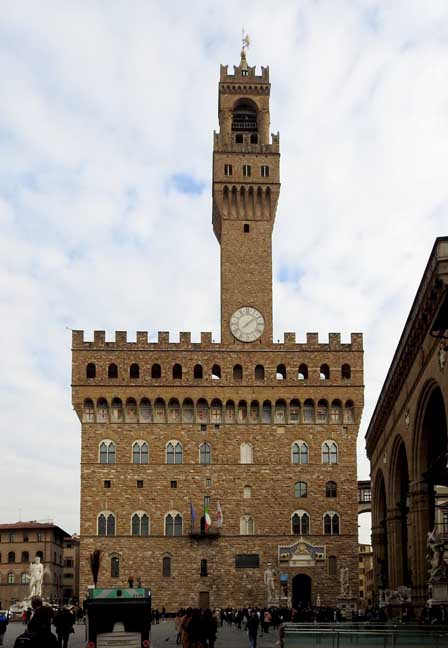 Neptune Fountain in lower left ... Loggia della Signoria at right ... The right side suspended bridge connects to the Uffizi Museum 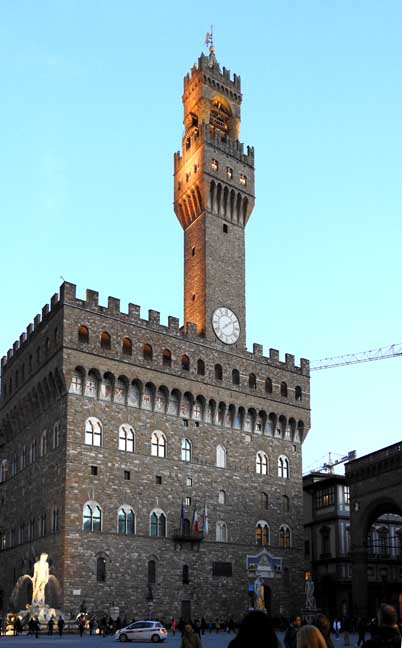 The tower is named after its designer: Torre d'Arnolfo ... This tower contains two small cells, that, at different times, imprisoned Cosimo de' Medici (the Elder) (1435) and Girolamo Savonarola (1498) ... Note the Fountain of Neptune at lower left, lit up  Torre d'Arnolfo Finial: Florence's fleur-de-lis which, unlike similar symbols, includes two pistils 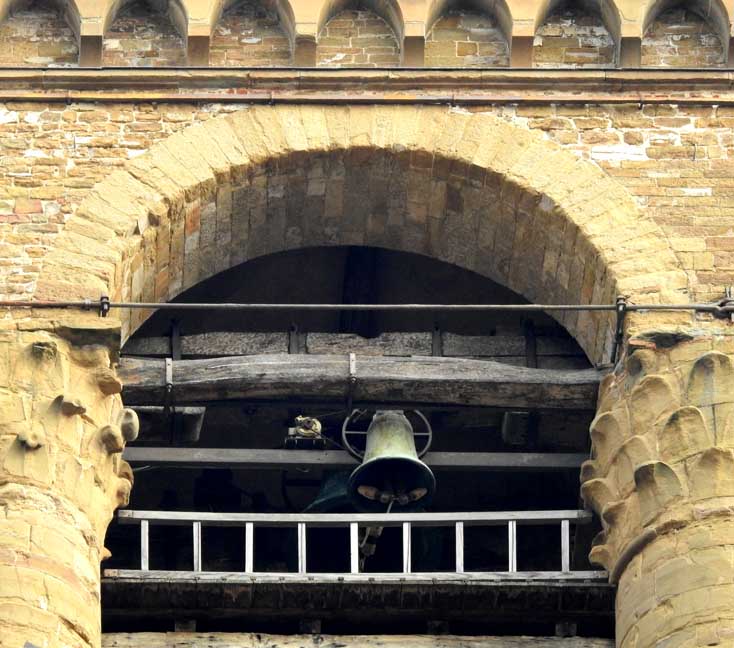 Torre d'Arnolfo Belfry ... The tower currently has three bells - the oldest was cast in the 13th century 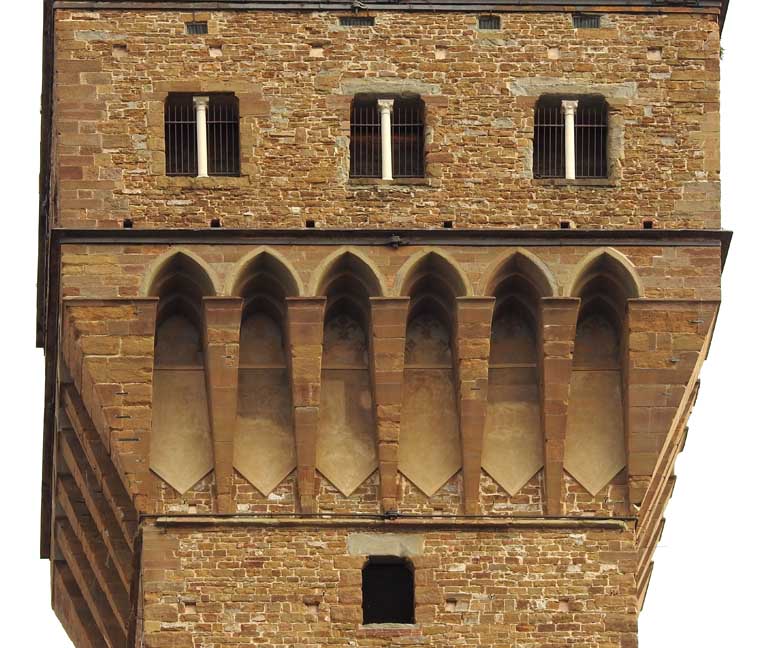 Torre d'Arnolfo Corbel table ... Blind arcade 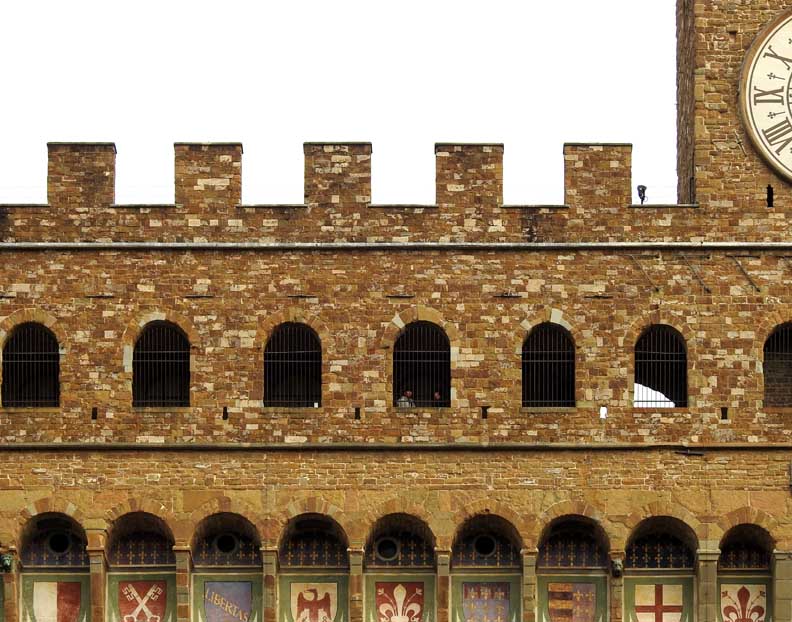 Tower at top right ... The building is crowned with projecting crenellated battlement, supported by small arches and corbel table. ... Under the arches are a repeated series of nine painted coats of arms of the Florentine republic. Some of these arches can be used as machiolation for dropping heated liquids or rocks on invaders.  Blind arcade ... Small arches and corbel table ... Second from left coat of arms : Florence's fleur-de-lis which, unlike similar symbols, includes two pistils 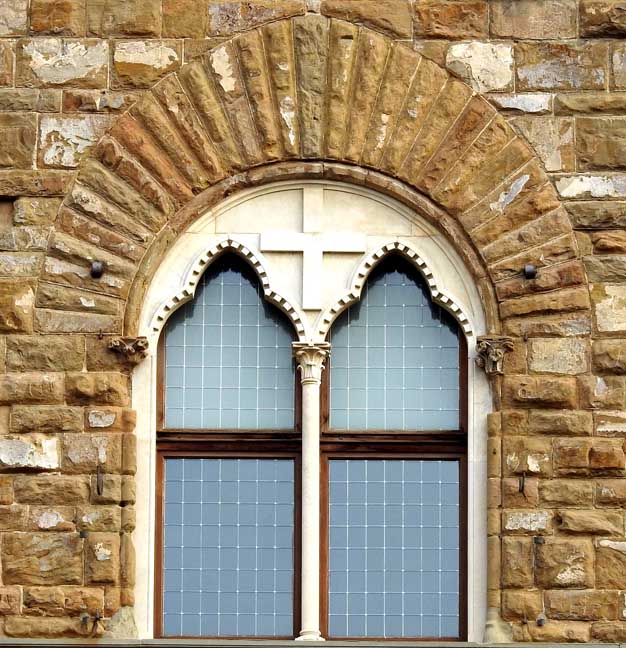 One of the two rows of two-lighted Gothic windows, each with a trefoil arch ... Corbels suporting rounded hoodmold |
Main
entrance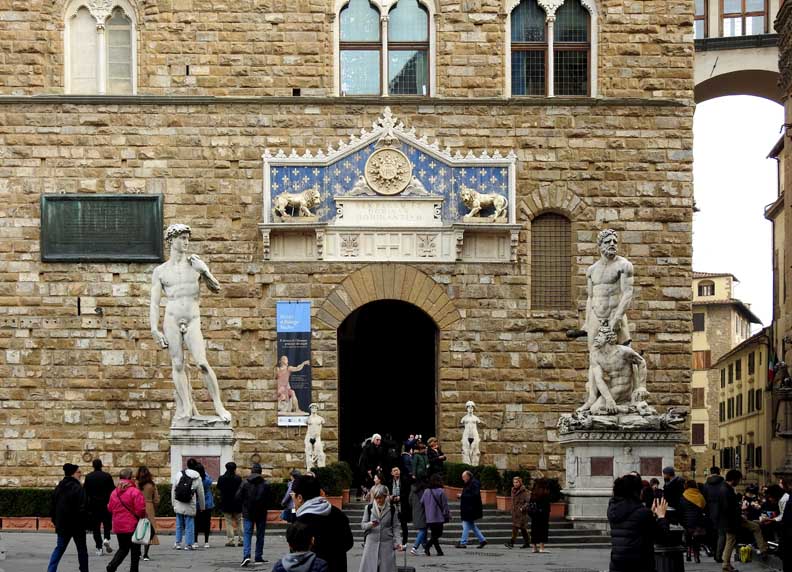 Frontispiece (decorative frame of the main door ) above main portal ... Voussoirs at top of arch ... Copy of "David" ... "Hercules and Cacus"  1528 frontispiece (decorative frame of the main door ) flanked by two gilded lions ... "Rex Regum et Dominus Dominantium" ("King of Kings and Lord of Lords") dates from 1851 ... Note the contrasting fleurs-de-lis: painted gold on blue, and carved pair with pistils 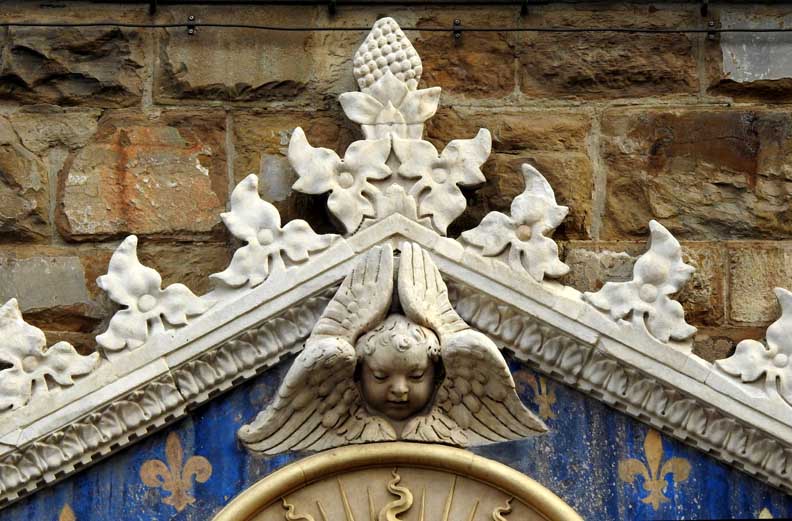 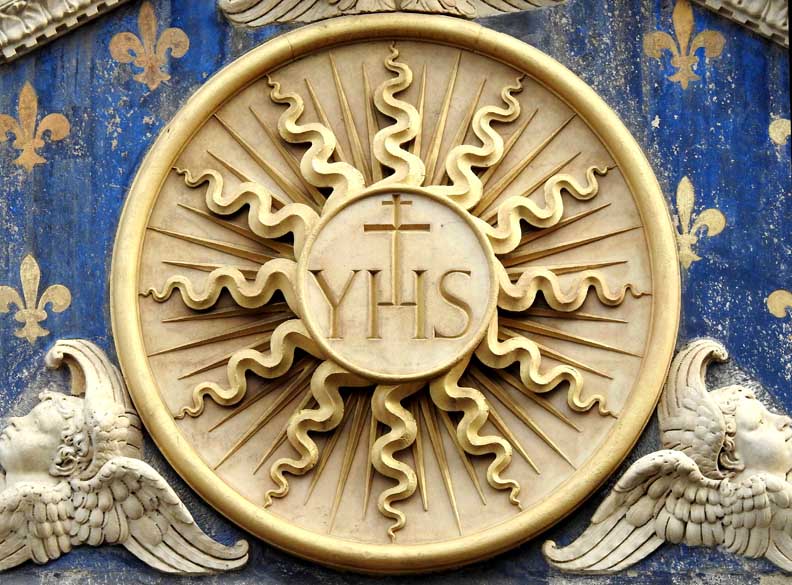 Christogram: YHS (IHS) ... Fleurs-de-lis 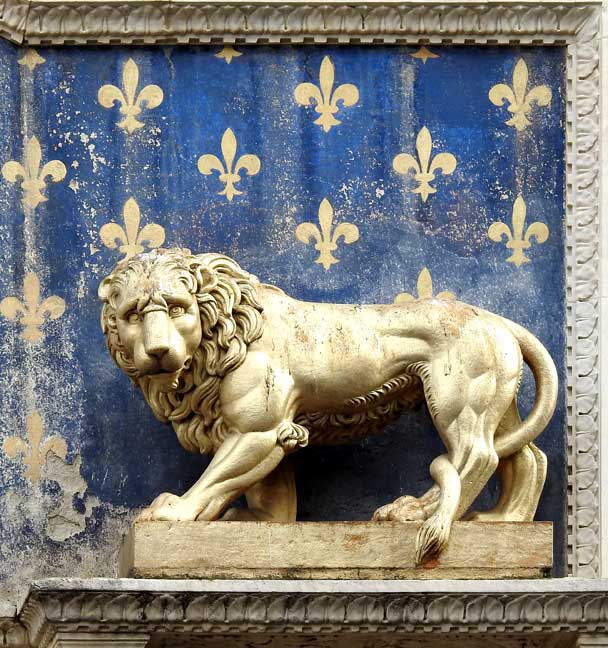 The heraldic lion—also known as the Marzocco lion—is the animal symbol representing the free Republic of Florence. As the legend goes, the Florentine Republic chose the symbol of the lion over other animals because lions are able to tear apart the eagle, which is the symbol of imperial power. |
Copy
of Michelangelo's "David"  Michelangelo's "David" stood at the entrance from its completion in 1504 to 1873, when it was moved to the Accademia Gallery. This replica erected in 1910 now stands in its place. See also a bronze replica in Buffalo's Delaware Park. |
Baccio
Bandinelli's "Hercules and Cacus" Baccio Bandinelli's "Hercules and Cacus" 1525-1534 ... Mannerist style ... Commisioned by the Florence Council ... "Although
descriptions of its unveiling in 1534 provided
verbal and written
criticisms of the marble, most were instead aimed
at the Medici family
for dissolving the Republic and were not
aesthetic. A few of the
writers of these hypercritical verses were
imprisoned by Alessandro
de'Medici, further suggesting a political
commentary. The two harshest
critics were Giorgio Vasari and Benvenuto Cellini,
both of whom were
champions of Michelangelo and rivals of Bandinelli
for Medici
patronage.The patrons (Medici family) were quite
satisfied and rewarded
Bandinelli greatly for his efforts with land,
money, and he was later
placed in charge of all sculptural and
architectural programs for the
Medici under Cosimo I." - Wikipedia:
Hercules
and Cacus (online April 2020)
Eleven
details below:
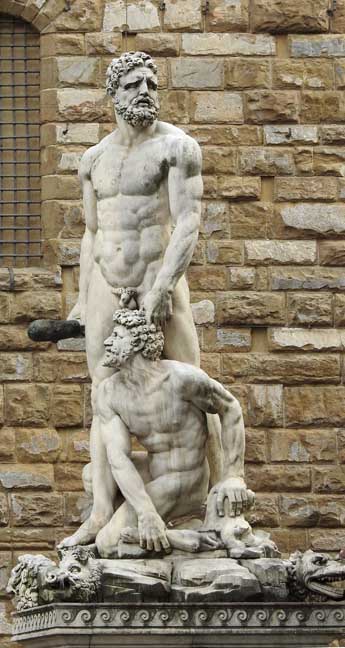 Bandinelli's "Hercules and Cacus" Twelve Labors of Hercules: during the tenth labor, killed the fire-belching monster Cacus for stealing cattle 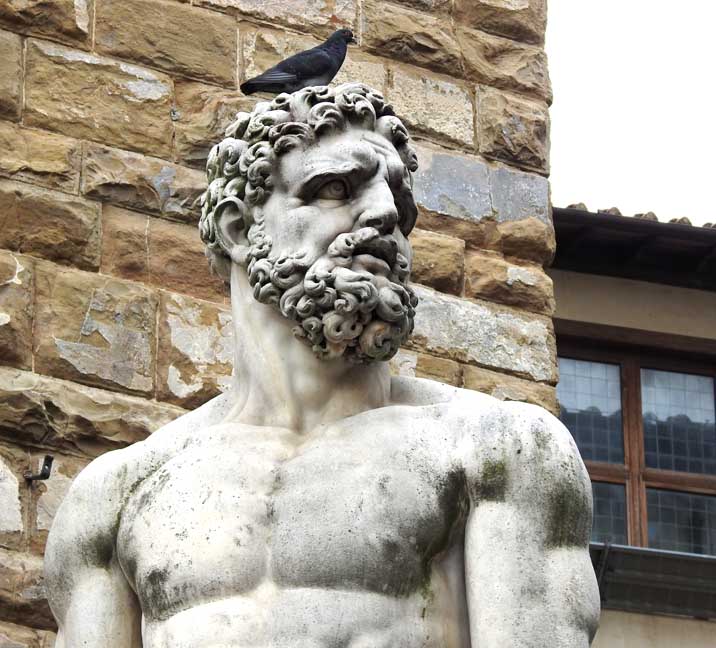 Bandinelli's "Hercules and Cacus" 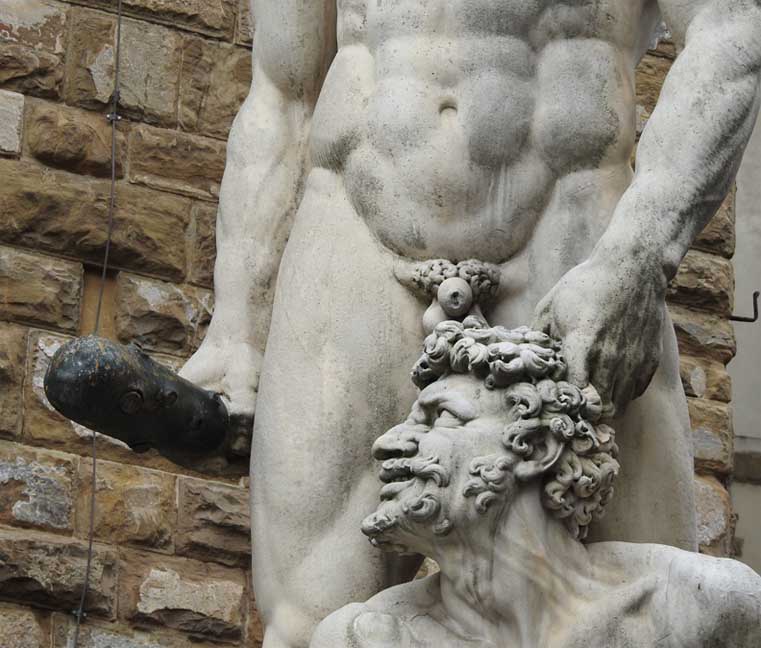 Bandinelli's "Hercules and Cacus" 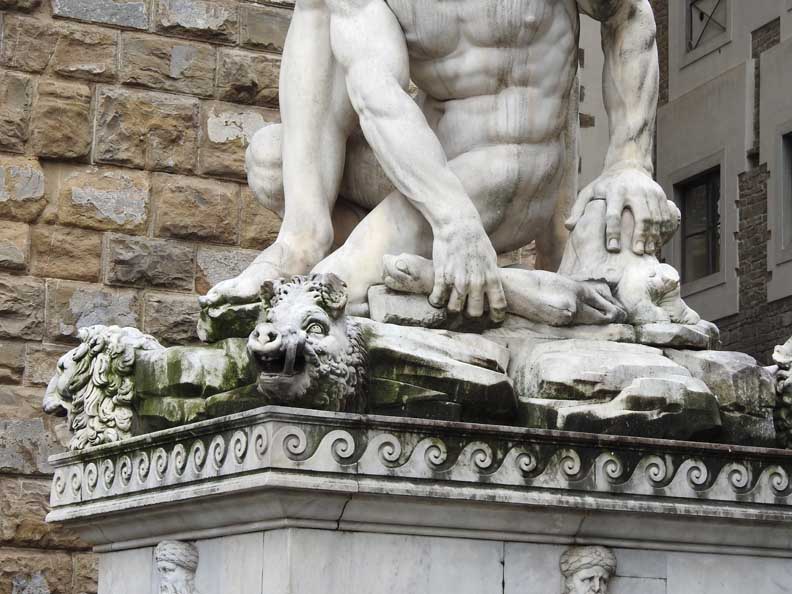 Bandinelli's "Hercules and Cacus" Vitruvian wave molding 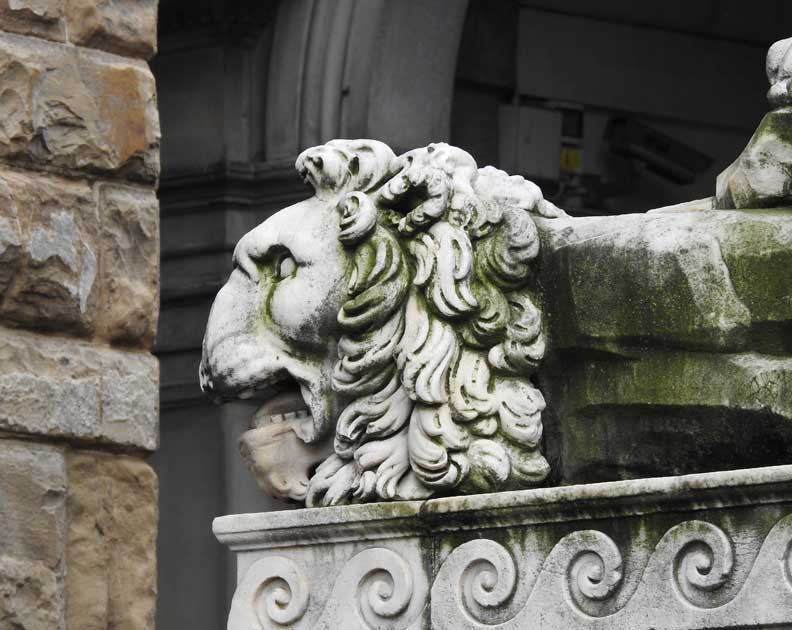 Bandinelli's "Hercules and Cacus" 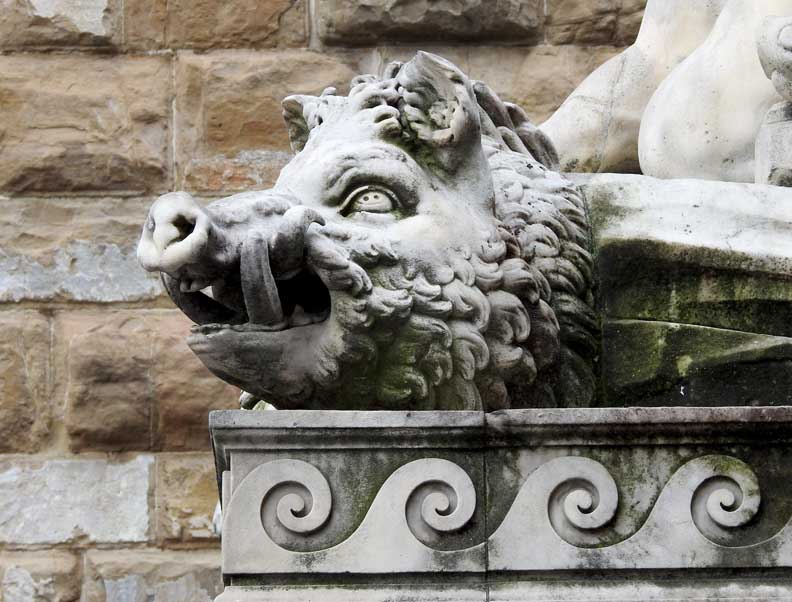 Bandinelli's "Hercules and Cacus" 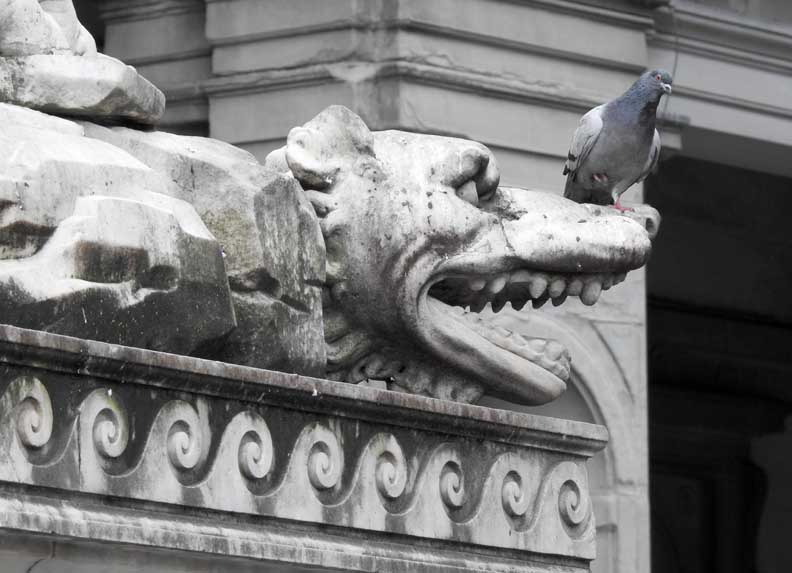 Bandinelli's "Hercules and Cacus"  Bandinelli's "Hercules and Cacus" 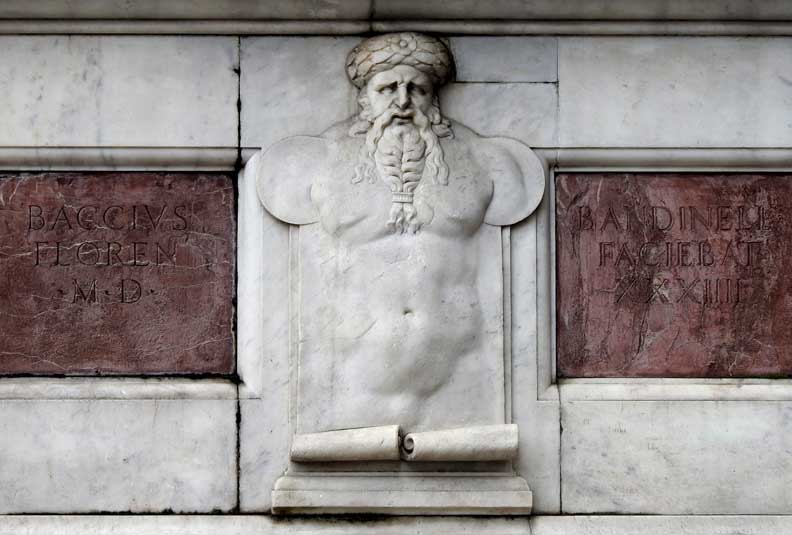 Bandinelli's "Hercules and Cacus" 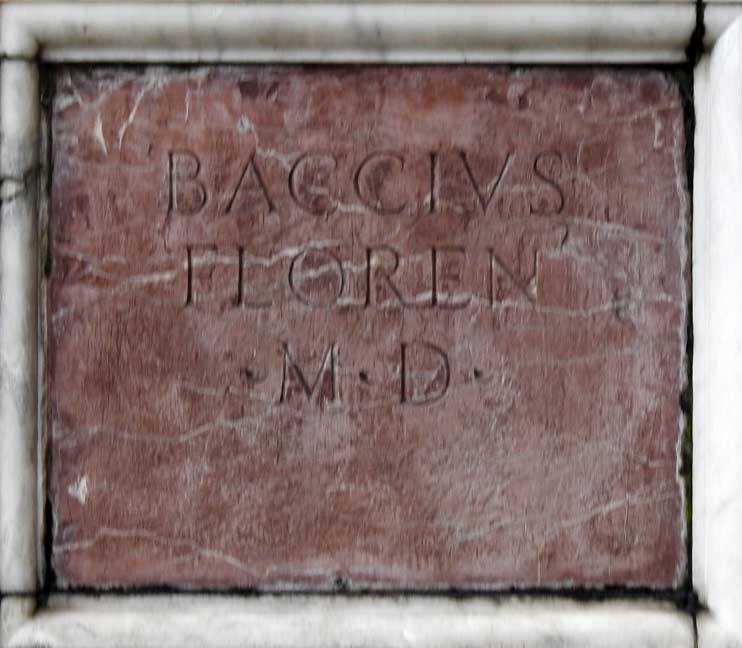 Baccio Bandinelli's "Hercules and Cacus"  Bandinelli's "Hercules and Cacus" |
Entrance courtyard 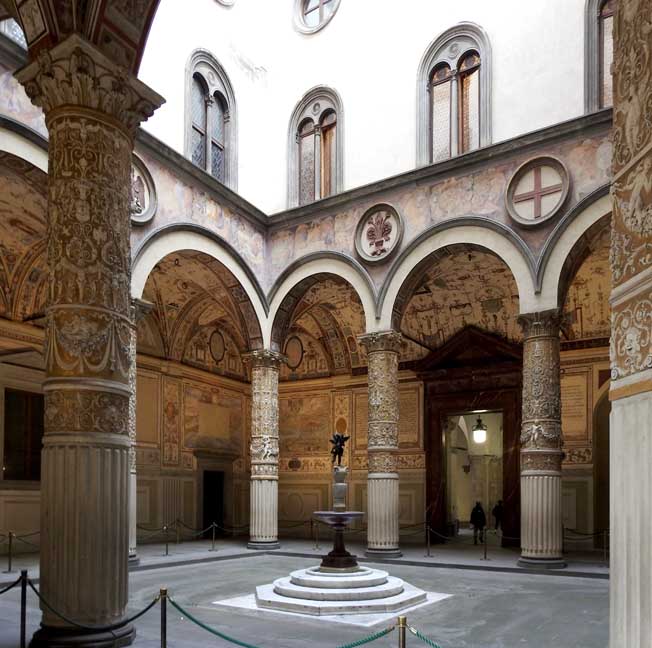 Entrance courtyard Designed in 1453 by Michelozzo ... Arcade windows ... Center fountain by Battista del Tadda 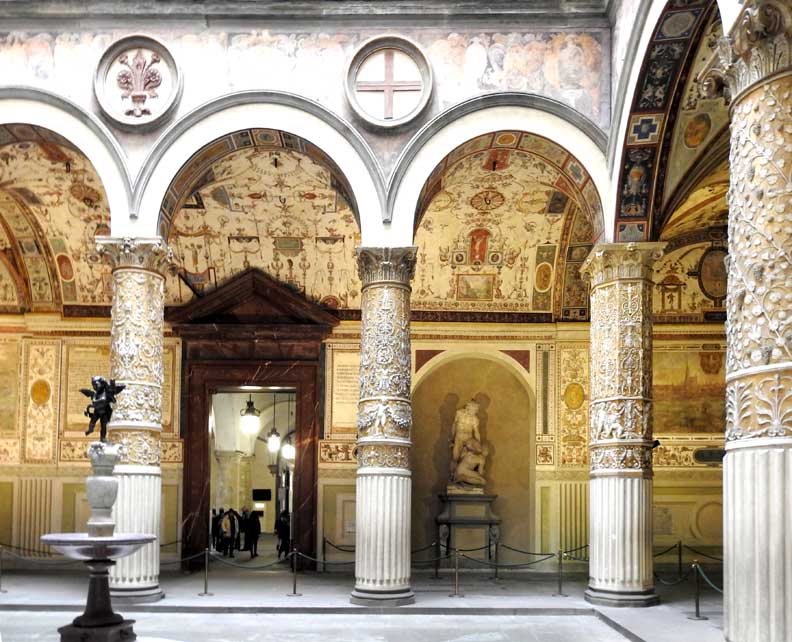 Entrance courtyard Arabesques decorate the ceilings ... Two medallions, which are detailed below ... Arcade ... Gilt and stucco decorate the Composite columns 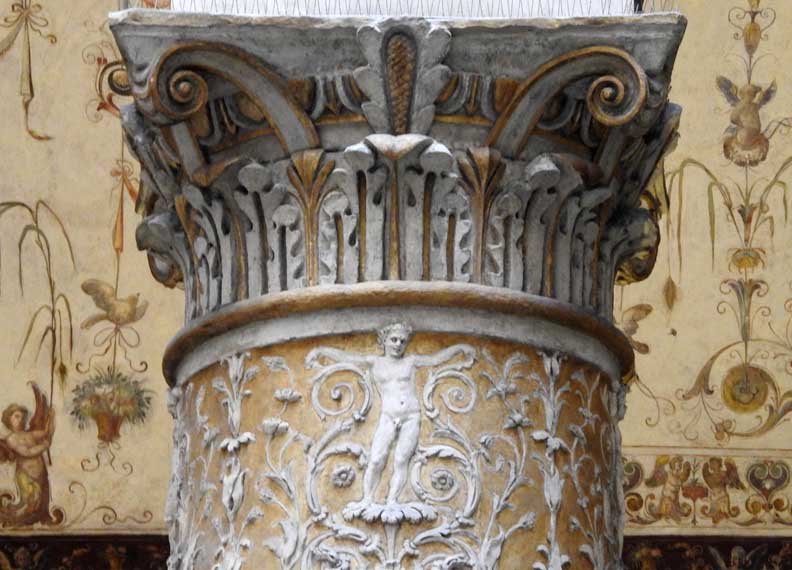 Entrance courtyard Composite column ... Scrolling acanthus leaves on shaft 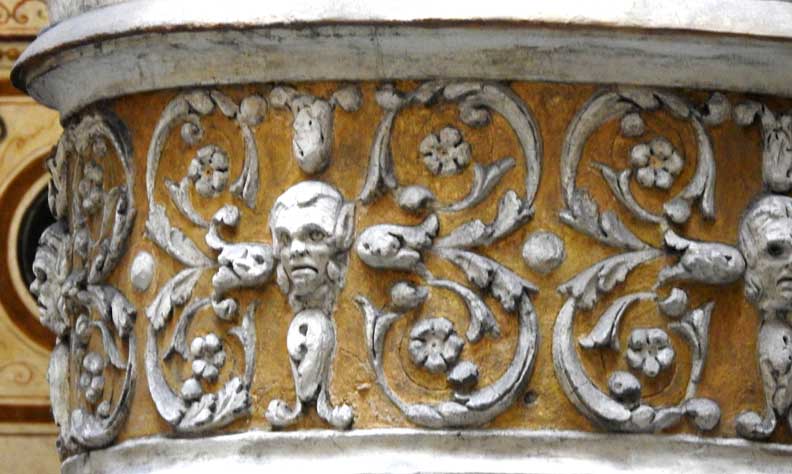 Entrance courtyard Grotesques and scrolling acanthus leaves 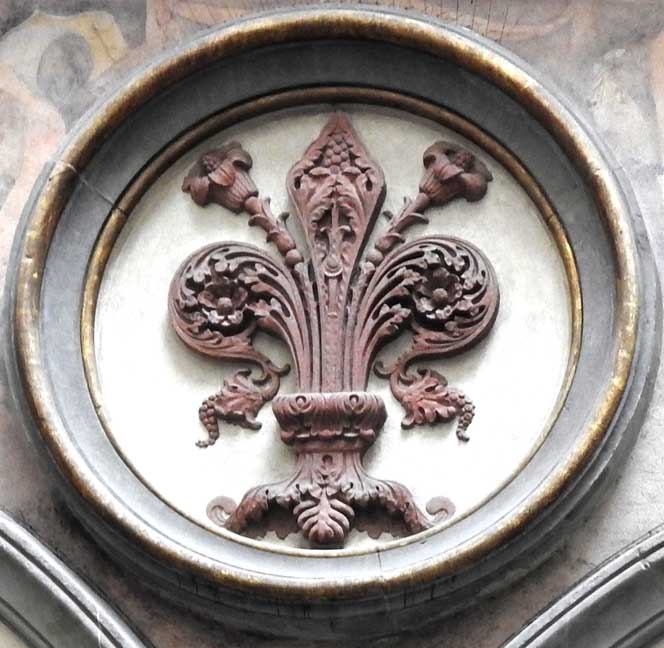 Entrance courtyard Florence's fleur-de-lis which, unlike similar symbols, includes two pistils 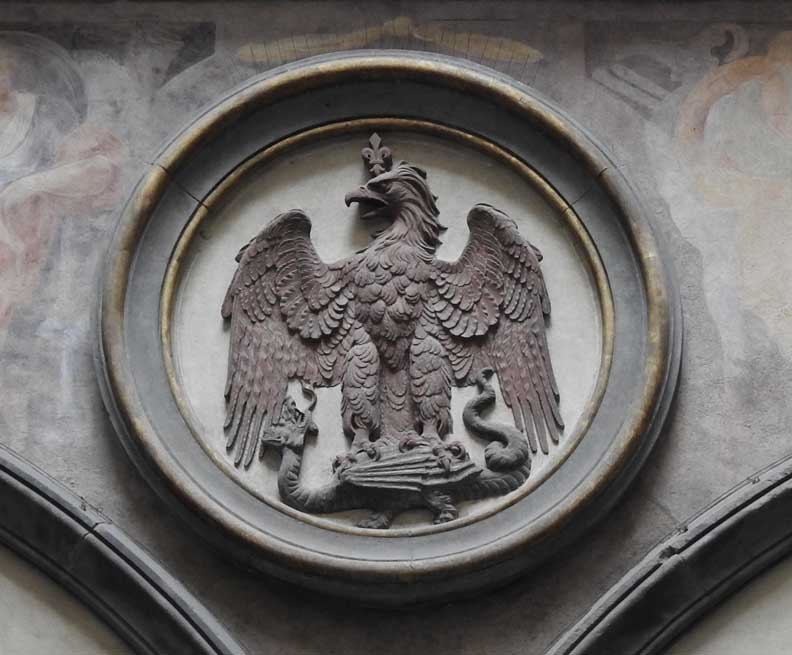 Entrance courtyard "Eagle Grasping the Dragon" ... The Guelphs and Ghibellines (eagle) were factions supporting the Pope and the Holy Roman Emperor, respectively, in the Italian city-states of central and northern Italy. 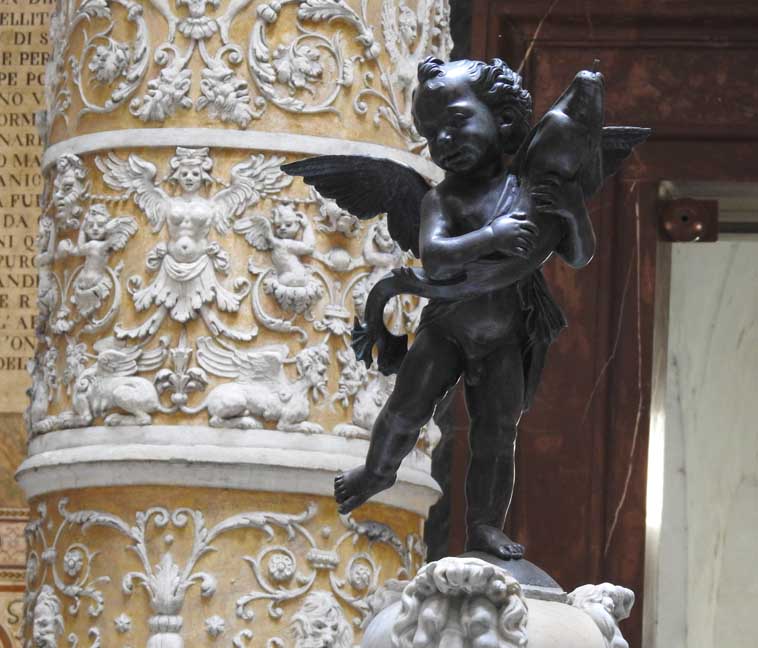 Entrance courtyard The "Putto with Dolphin" - an copy of which was originally made by Andrea del Verrocchio for the Villa Medici in Careggi, but it was brought to Palazzo Vecchio, when the son of Cosimo I married Joanna of Austria in 1565. ... Original now on display on the second floor of the palace ... The water, flowing through the nose of the dolphin, is brought here by pipes from the Boboli Gardens. which are located behind the Palazzo Pitti where Cosimo I moved c. 1850 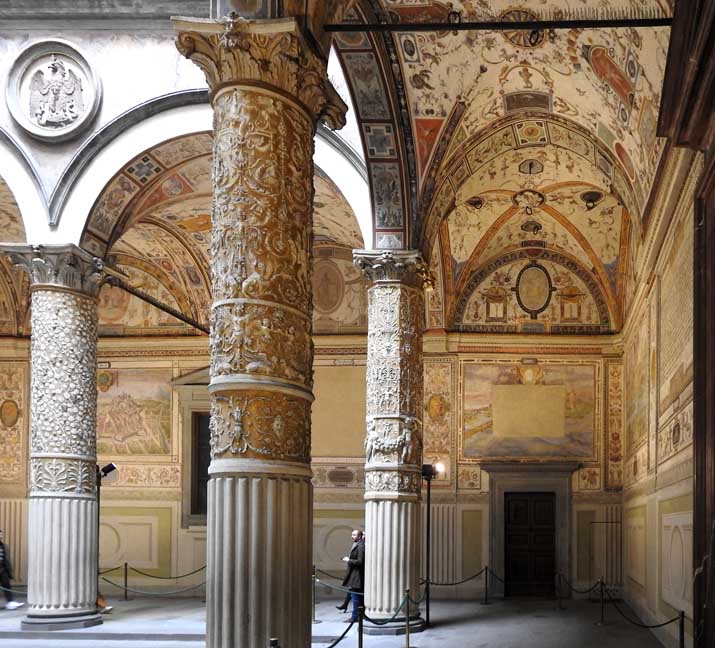 Groined vaults decorated with arabesques 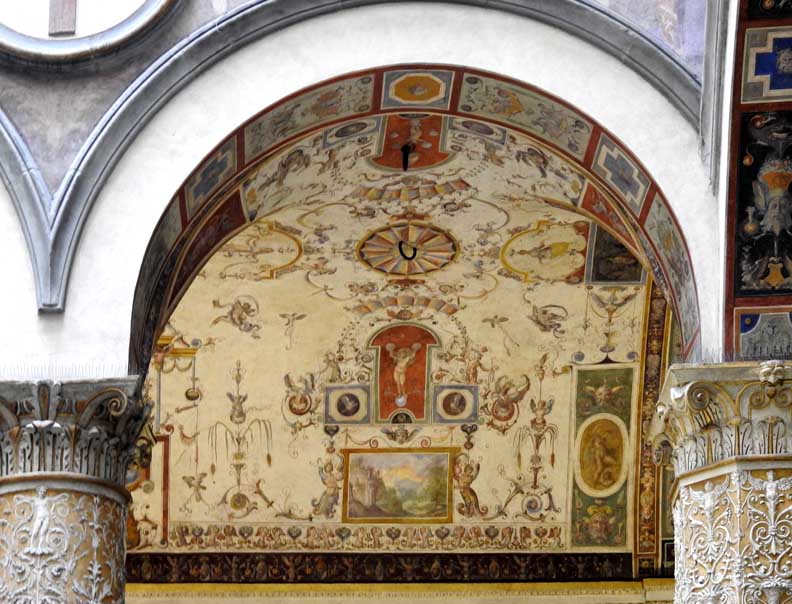 Entrance courtyard Renaissance style (Mannerist) arabesque decorations ... Barrel ceiling ... Detail below: 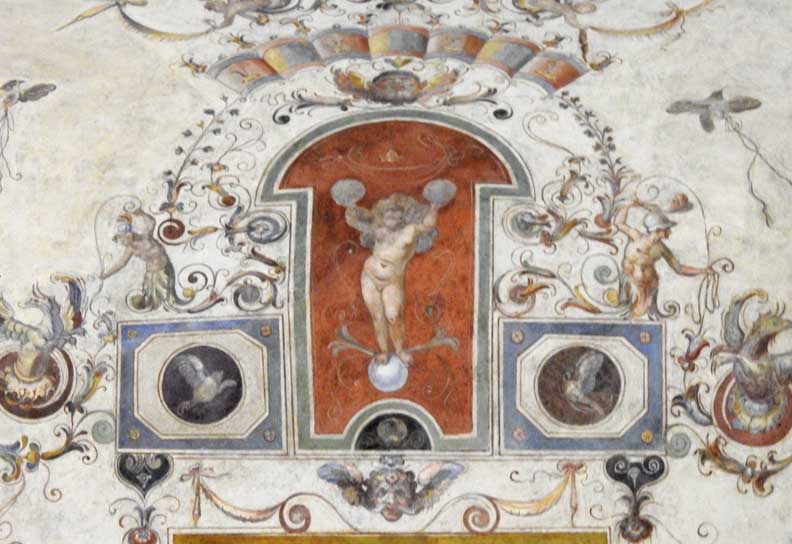 Entrance courtyard Arabesque decorations feature grotesques 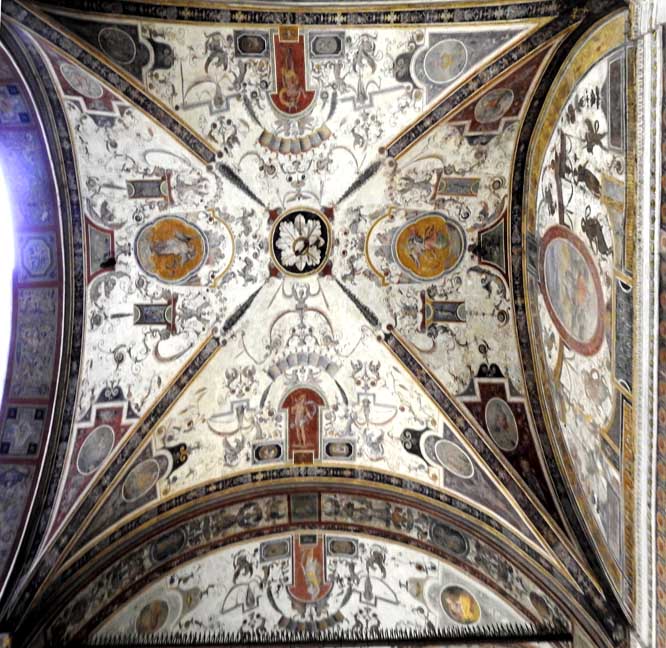 Groin vault ... Detail below: 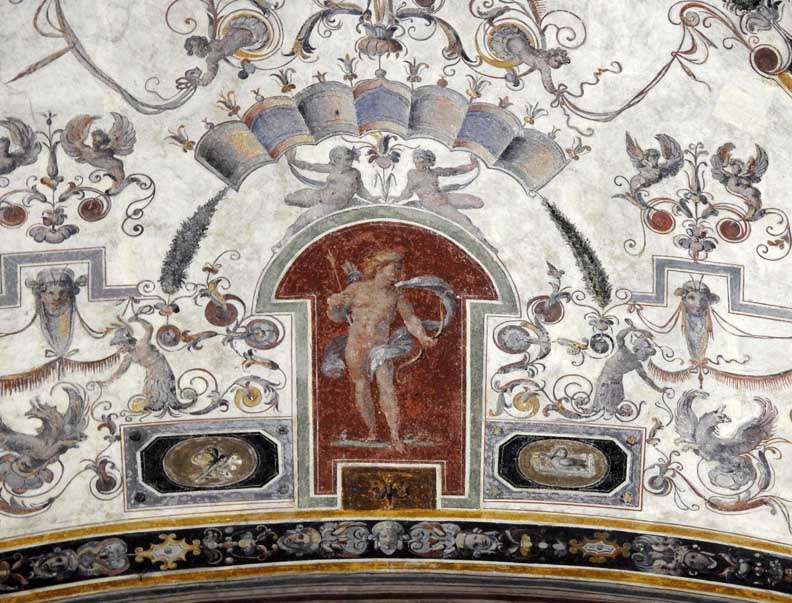 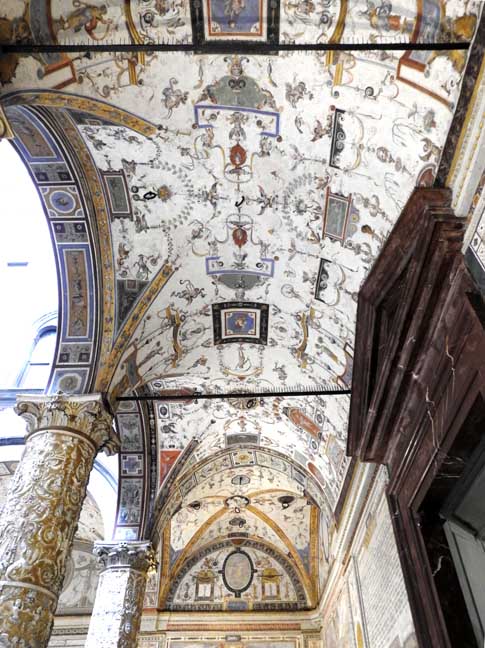 Note two supporting tie rods ... Lower half detail below: 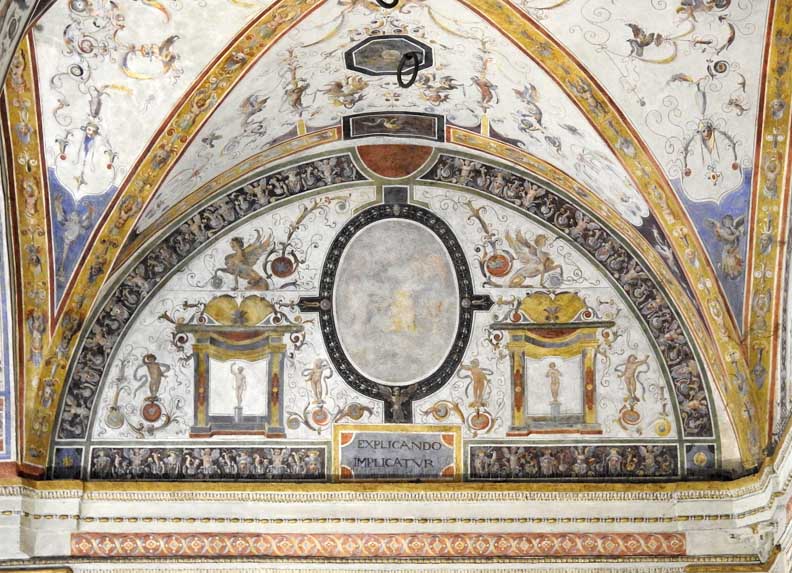 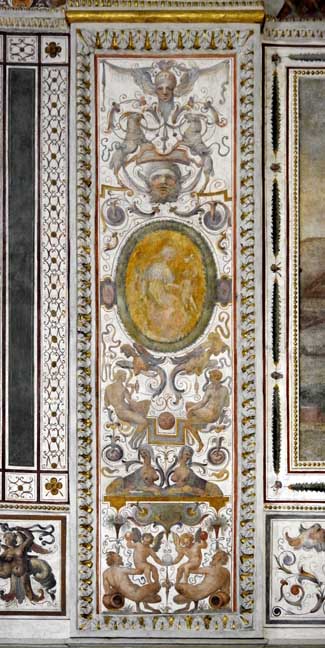 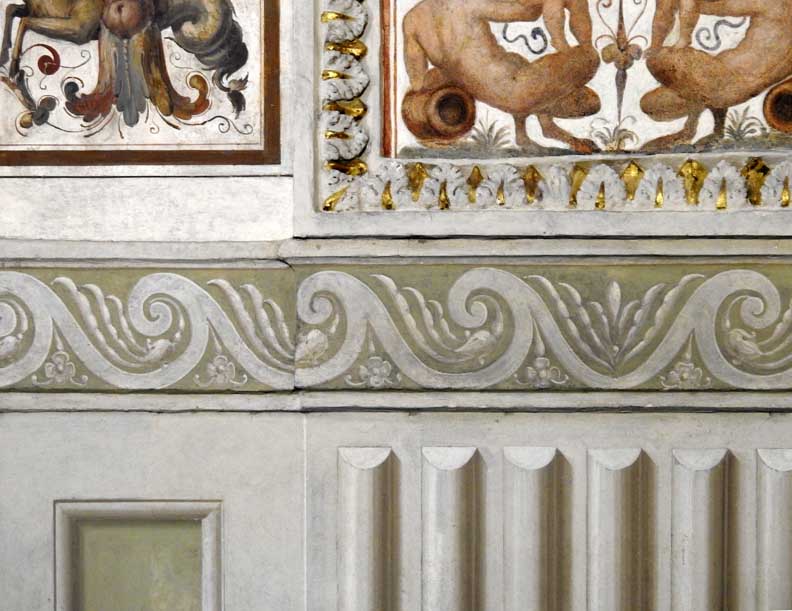 Vitruvian wave ... Reeds |
|
Palazzo Vecchio
The secular center of the community, the town hall, was almost as much the object of civic pride as the cathedral. This tall structure served as lookout over the city and the countryside around it and as a bell tower from which signals of all sorts could be rung to the populace. The medieval city, a self-contained political unit, had to defend itself against neighboring cities and often against kings and emperors; in addition, it had to be secure against internal upheavals, which were common in the history of the Italian city-republics. Feuds between rich and powerful families, class struggle, even uprisings of the whole populace against the city fathers were constant threats to a city's internal security. The heavy walls and battlements of the Italian town hall eloquently express the frequent need of city governors to defend themselves against their own citizens.The high tower, out of reach of most missiles is further protected by machicolated galleries - projecting galleries at the top of a castle wall, supported by a row of corbeled arches and having openings in the floor through which stones and boiling liquids could be dropped on attackers. The bell of the Palazzo Vecchio tower summoned Florentine citizens to this piazza to hear announcements or see justice enacted in its grimmest form. The great bell in the tower now tolls only at the bleakest of times: after the German occupation of Florence on August 11, 1943, after the flood of November 4, 1966, and after the terrorist bombing of the Uffizi on May 27, 1993. Palazzo Vecchio, built in rustic embossment, is adorned by two rows of two-light mullioned windows and several other windows under a jutting balcony, the whole being crowned by the graceful tower called the Tower di Arnolfo. Originally (1298-1343) the palace, that was mistakenly thought to be the work of Arnolfo di Cambio, was composed of only the part standing under the battlemented balcony It was enlarged later - the parts added at the opposite sides are clearly to be seen - and it was entirely restored inside up to the end of the 16th century. Under the projections of the balcony, we see painted the coats-of-arms and the emblem, of the Republic, together with the coats-of-arms of its protectors and allies. The tower (94 meters) rises straight from the balcony. Under the bell cell there is also a balcony resting on a projection, ornamented by three two-light mullioned windows on each side. The tower held political prisoners. The Palace was the seat of the Republic and, consequently, of the Signoria, until the middle of the 16th century. In 1540 Medici Grand Duke Cosimo I and his wife Eleanor of Toledo transformed the bureaucratic building into a sumptuous residence, hiring Georgio Vasari to design an interior which would glorify the Medici and their rule (all that money couldn't overcome Eleanor's dislike for of her new home and she spurred Cosimo to move to the Pitti Palace in 1549). The building was originally named the Palazzo della Signoria, but renamed after Cosimo moved here with with his family. It functions now as Florence's City Hall. Sources:
|